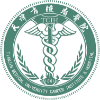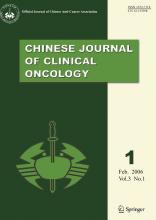keywords
A 10-year-old boy appeared with a headache, mainly in the forehead, and with lethargy at noon on November 10, 2004. He reported discontinuous gas pains, no nausea, no vomiting and no blurred vision. He thought that he had a “common cold”, but treatment for 3 days produced no result. He was diagnosed as having viral encephalitis after an examination including an electroencephalogram (EEG), blood biochemistry and lumbar puncture, etc. in a local hospital on November 15. After further treatment for 3 days his symptoms became aggravated showing instability of gait and involuntary movement of his head and extremities. Cranial CT showed: a 4.0 cm× 4.0 cm× 5.0 cm lump in the cerebellar vermis which intruded into the fourth ventricle inducing evident distention of the third and lateral ventricle. He was diagnosed with blastoma of the cerebellum.
On November 25 he went to the third hospital in our city and immediately was given drainage outside of the lateral ventricle because ventricular distention was obvious. The patient’s condition was somewhat relieved but his binaural listening and binocular vision were decreased.
On November 29, after a MRI examination, he was diagnosed with a germinoma which has a high possibility of malignancy. On December 4 the patient received a tumorectomy and the pathological report was an endodermal sinus tumor. He was unconscious for 2 days after the operation. On the third day he responded to questions and had control of urination and defecation. On the fourth day after the operation the patient’s condition suddenly became worse with urinary and fecal incontinence.
On December 13 the patient was transferred to our hospital. Physical examination: body temperature (BT) 36.6°C, pulse 96 times/min, respiration 19 times/min, BP 130/80 mmHg, lethargic and with no response to questions. The operation scar at the top of the right frons and occiput had healed well. Sometimes his head moved involuntary. Light reflex of pupils was dull. He receiced nasal feeding and had no ability to open his mouth or extend his tongue. His neck had a feeling of resistant and his extremities moved involuntarily. There was no edema of either lower extremities (BLE). Muscular tension of extremities was high and muscle power was IV grade. Patella tendon reflex (PTR) was accentuated, ankle-clonus (+) and bilateral Babinski sign (+). Immediate cranial CT examination showed that the density of the cerebellar region was uneven, the fourth ventricle and quadrigeminal cistern was indistinctly displayed, the brain stem was compressed slightly, the ventricular system was obviously distended and there was a local absence of the occipital bone on part of the CT slice.
The patient was given an emergency lateral ventricle-abdominal bypass, but his condition at that time showed no evident improvement. Then the patient developed an upper gastrointestinal hemorrhage (UGIH) and a repeated fever. His dependents refused further treatment and he was diacharged. The patient died on January 6, 2005.
Summary
An endodermal sinus tumor is regarded as having its origin from multipotential germinal cells. It is mainly seen in the gonads, i.e. the ovary and testicle. A few cases have been reported in extragonadal organs e.g. post-peritoneum, mediastinum, parotid gland [1] and heart, etc. It is extremely rare as a primary intracranial lesion. [2,3] Some reports have indicated an age of onset of 5 to 24 years, mainly at about 10. Subtotal tumors are located on a saddle and in the region of the pineal body. Individual tumors are located in the cerebullar peduncle of the pons, while in this case it was located in the cerebellar vermis which is all the more rare. Because this disease lacks characteristic clinical manifestations and specific imagery, it is easily misdiagnosed. Final diagnosis requires pathological confirmation after an operation. The degree of malignancy of this tumor is extremely high. Operating excision is not easily completed and it is prone to relapse after operation. In addition this disease is not sensitive to radiotherapy and chemotherapy, so there has no effective treatment at present.
- Received July 12, 2005.
- Accepted September 26, 2005.
- Copyright © 2006 by Tianjin Medical University Cancer Institute & Hospital and Springer











